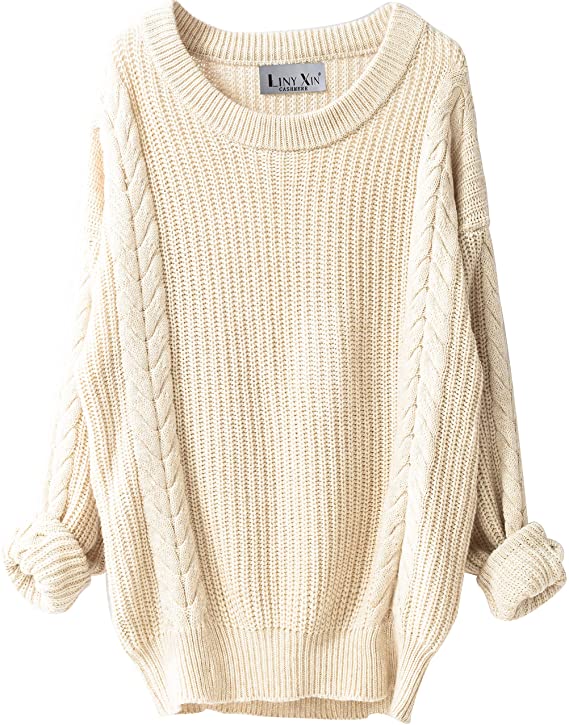Cashmere is a luxurious, soft material derived from the hair of an animal called a cashmere goat.
How is Casmere Gathered?
Cashmere goats are typically found in China and Mongolia. The animals live in mountainous regions, where they enjoy cool weather and short summers. It takes about one year for the goat’s coat to grow; then it is sheared once per year, usually during March or April when temperatures are moderate enough not to harm the animal’s sensitive skin.
Cashmere wool fibers measure 18-20 microns (µm) in diameter; this makes them finer than sheep wool fibers (which average 55 µm), but thicker than cotton fibers (which average 10 µm). This combination of thinness and thickness make cashmere exceptionally warm without being heavy.
Cashmere has a unique feel, making it an ideal material for garments that touch the skin. In fact, cashmere is often used to make sweaters, gloves and shawls.
Example
LINY XIN Women’s Cashmere Oversized Sweater

This Liny Xin cashmere women’s oversized sweater is made from fine, downy undercoat of Kashmir goats that produce the highest quality fibers. They are then hand washed and spun into sumptuous two-ply yarns twisted to resist pilling without compromising strength. Lightweight, super soft, incredibly smooth with an amazing wearing experience for this must have item in fall and winter days.
This is a woman’s oversized sweater knit from a cashmere and wool blend. The sweater is special for its that it has been treated to resist pilling without compromising strength, which means you’ll have the best of softness with longevity as well! This soft and comfortable quality will keep you cozy on those chilly fall nights. With this chic style, the Liny Xin Women’s Oversized Cashmere Sweater is perfect for any outfit.
Different Types of Cashmere
In terms of quality, cashmere material is divided into three categories: commercial grade, which has longer fibers; first grade, which has shorter fibers; and kid mohair or baby cashmere , which is a fine first-grade cashmere made from the first shearing of a goat kid. However, some people consider “kid” as being equivalent to first-grade cashmere .
The main difference among these types have more to do with fineness rather than how they are derived from animals. Softer Cashmere will be of higher quality but more expensive, while coarser Cashmere will be cheaper and of less quality.
First-grade cashmere may range from 7 to 20 microns (µm) in diameter, whereas baby cashmere fibers must measure under 15 µm in diameter, according to the Better Cotton Initiative. Fine Cashmere is softer than commercial or baby Cashmere because it has thinner shafts that are given a light spinning process. This results in fewer cross sections at any point along its length, meaning fewer coarse fibers are present to tangle together and cause pills.
Kid mohair yarn is soft enough for even the finest fabrics, which makes it perfect for lace applications. It adds an ethereal beauty to shawls and other accessories. However, there are some issues associated with kid mohair yarn. The finer the threads get, the more easily they can break and unravel , because their core is very weak.
Kid mohair also has a tendency to stretch out of shape when it’s used in applications where weight is applied (such as sweaters), which means that knitters must use caution when using this material for heavier garments or accessories like shawls .
Cashmere that will be dyed often begins with commercial-grade Cashmere, which has longer fibers than first-grade cashmere; it’s easier for dyeing processes to penetrate longer fibers.
As far as color goes, cashmere comes in various shades including white, brownish gray and black. If you are purchasing cashmere yarn, it’s best to look for “undyed” or “raw” cashmere because the dyeing process is so harsh. Undyed cashmere will be of higher quality and pricier, while dyed commercial-grade Cashmere will be of lower quality and less expensive.
Cashmere sweaters that are made from first-grade fibers often have a more luxurious feel than those made from commercial-grade material because they’re softer, more lightweight yet still warm .
Kid mohair has an enchanting luster that make it perfect for shawls, scarves and wraps. It adds volume without becoming heavy. With kid mohair , there are fewer pills because its fine threads provide less surface area to catch lint. It is also more elastic than other types of Cashmere, making it safe for light-weight garments that need stretch. Other benefits include its fine texture which makes it soft to the touch and provides an ethereal look to accessories like shawls .
However, kid mohair yarn does have its downsides. It is very fragile, which means that it will easily break if used in applications where weight is applied (such as warm sweaters). Knitters must be cautious when using this material for heavier garments or accessories like shawls .
Additionally, kid mohair has a tendency to stretch out of shape when it’s used in applications where weight is applied (such as sweaters), which means that knitters must use caution when using this material for heavier garments or accessories like shawls .


